
个人主页:一代...
个人专栏:数据结构

1. 定义:
- 堆通常是一个可以被看做一棵树的数组对象,在物理层面上表现为顺序存储结构,但在逻辑层面上是完全二叉树的形态,这意味着除了最后一层外,每一层都被完全填满,且最后一层从左到右填充。
- 堆中某个结点的值总是不大于或不小于其父结点的值,这一性质使得堆成为最高效的优先级队列。
(注意:大堆和小堆的实现都是用数组来实现的,其物理结构是数组 但其逻辑结构是一颗完全二叉树)
用数组实现堆,假设其双亲节点的下标为i,则其左孩子节点的下标为2*i+1,右孩子节点的下标为2*i+2
若孩子节点的坐标为i(这里的孩子节点无论是左孩子还是右孩子),其双亲节点的坐标都为(i-1)/2;
如果想要一个数组变为堆,首先要把其看做完全二叉树的结构
如数组a[4]={2,1,3,4}
将其理解为树的结构就变为:(理解为树的结构后就可以对其进行操作,将其变为大堆或小堆)
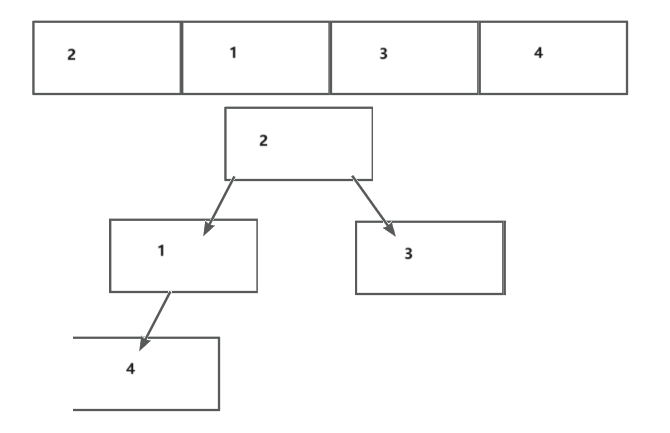
2. 堆的分类
堆分为大堆和小堆
- 大堆:大堆的双亲节点都大于其孩子节点
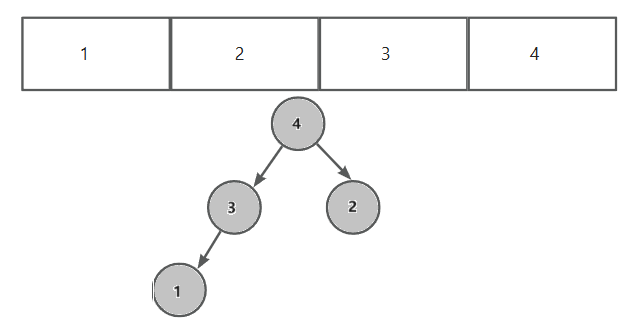
- 小堆:小堆的双亲节点都小于其孩子节点
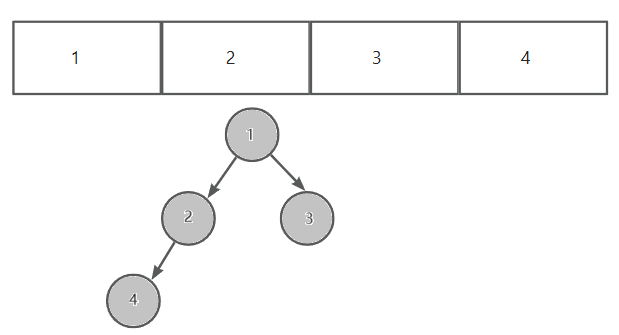
3. 堆的实现
a. 堆的结构体定义:
typedef int HPDataType; typedef struct Heap { HPDataType* a; int size; int capacity; }HP;b. 堆的初始化
void HPInit(HP* php) { php->a = NULL; php->capacity = php->size = 0; }c. 堆的建立
ⅰ. 向上调整法
向上调整法要从第一个元素开始,向上调整法建小堆时,当孩子节点小于双亲节点时,孩子节点的值就和父亲节点的值交换,孩子节点坐标等于双亲节点的坐标,双亲节点的坐标变为(双亲节点的坐标-1)/ 2,当孩子节点==0时循环结束。
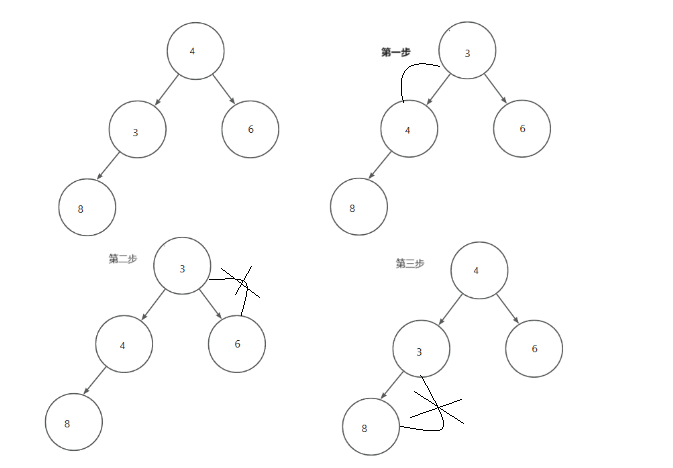
void Swap(HPDataType* a, HPDataType* b) { HPDataType tmp = *a; *a = *b; *b = tmp; } void AdjustUp(HPDataType* a, int child) //不传结构体,为了后面排序做准备,原因后面会解释 { assert(a); int parent = (child - 1) / 2; while (child > 0) //parent>=0可以作为结束条件,但是一个巧合, //因为到最后是依靠当child==0,parent=(child-1)/2=-1/2=0时 //a[parent]==a[child]结束的 { if (a[child] < a[parent])//建小堆,若a[child]>a[parent]就建大堆 { Swap(&a[child], &a[parent]); child = parent; parent = (parent - 1) / 2; } else { break; } } }1. 向上调整法建堆
void Swap(HPDataType* a, HPDataType* b) { HPDataType tmp = *a; *a = *b; *b = tmp; } void AdjustUp(HPDataType* a, int child) //不传结构体,为了后面排序做准备,原因后面会解释 { assert(a); int parent = (child - 1) / 2; while (child > 0) //parent>=0可以作为结束条件,但是一个巧合, //因为到最后是依靠当child==0,parent=(child-1)/2=-1/2=0时 //a[parent]==a[child]结束的 { if (a[child] < a[parent])//建小堆,若a[child]>a[parent]就建大堆 { Swap(&a[child], &a[parent]); child = parent; parent = (parent - 1) / 2; } else { break; } } } void HPInitArray(HP* php, HPDataType* a, int n) { assert(php); php->a = (HPDataType*)malloc(sizeof(HPDataType) * n); if (php->a == NULL) { perror("malloc fail!"); return; } memcpy(php->a, a, n * sizeof(HPDataType)); php->capacity = php->size = n; //向上调整 for (int i = 1; i < n; i++)//这里遍历要从下标为1的元素开始,即从第一个孩子节点开始 { AdjustUp(php->a, i); } } int main() { HPDataType a[] = { 50,100,480,76,31,31,226 }; HPSort(a, sizeof(a) / sizeof(a[0]));//之前向上调整和向下调整就是为了这里 //直接传a数组,而不是 for (int i = 0; i < sizeof(a) / sizeof(a[0]); i++) { printf("%d ", a[i]);//排升序 } HP hp; HPInit(&hp); HPInitArray(&hp,a,sizeof(a)/sizeof(HPDataType)); return 0; }2. 向上调整法建堆的时间复杂度
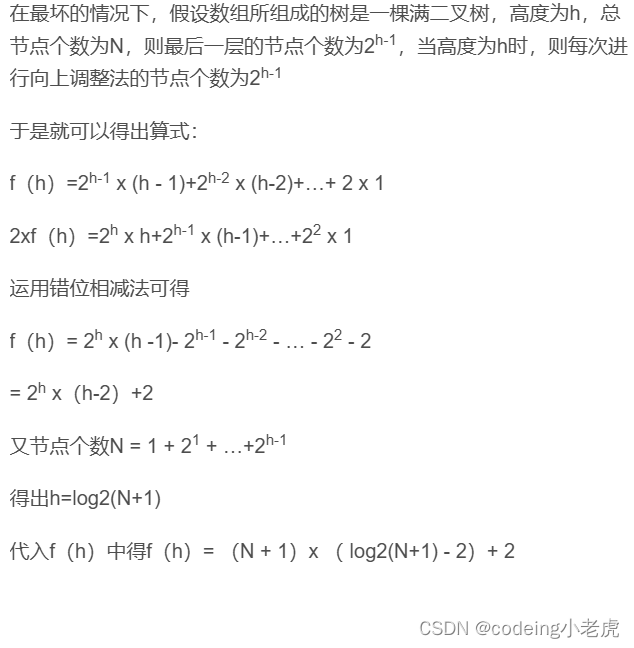
所以向上调整建堆的时间复杂度为O(N*logN),向上调整法的时间复杂度为O(logN)(即调整高度次)
ⅱ. 向下调整法
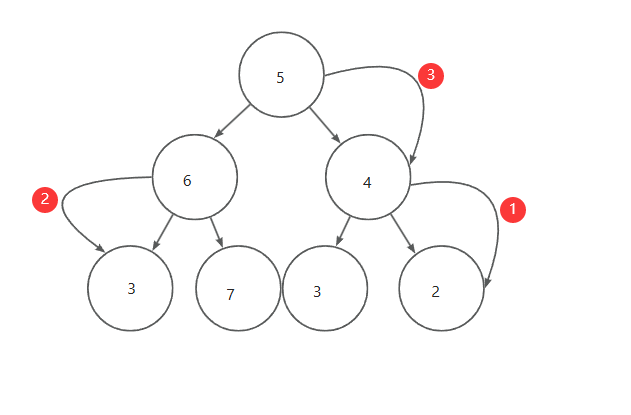
转换之后就变为小堆
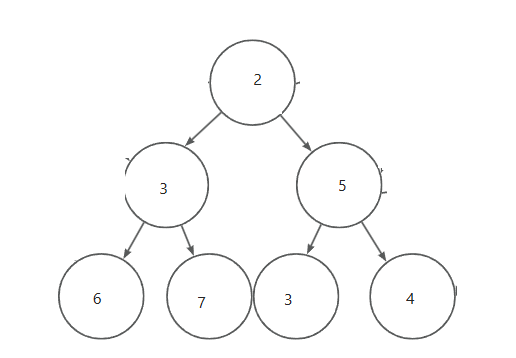
向下调整法时要从最后一个元素的双亲节点开始,在向下调整建小堆的过程中,用假设法选出左右孩子中最小的一个,当孩子节点大于双亲节点时,孩子节点就和双亲节点交换,双亲节点等于孩子节点,孩子节点等于双亲节点*2+1(不可以为双亲节点*2+2,必须为有孩子·,以便后面比较左右孩子的大小),当孩子节点的坐标大于等于总数组的大小时,就跳出循环
void Swap(HPDataType* a, HPDataType* b) { HPDataType tmp = *a; *a = *b; *b = tmp; } void AdjustDown(HPDataType* a, int n, int parent) //不传结构体,为了后面排序做准备,原因后面会解释 { assert(a); int child = parent * 2 + 1; while (child < n) { //假设法 if (child + 1 < n && a[child] < a[child + 1]) { child++; } if (a[parent] < a[child]) { Swap(&a[parent], &a[child]); parent = child; child = parent * 2 + 1;//右孩子,不可以为左孩子,因为上面要比较 } else { break; } } }1. 向下调整法建堆
void Swap(HPDataType* a, HPDataType* b) { HPDataType tmp = *a; *a = *b; *b = tmp; } void AdjustDown(HPDataType* a, int n, int parent) //不传结构体,为了后面排序做准备,原因后面会解释 { assert(a); int child = parent * 2 + 1; while (child < n) { //假设法 if (child + 1 < n && a[child] < a[child + 1]) { child++; } if (a[parent] < a[child])//建大堆 { Swap(&a[parent], &a[child]); parent = child; child = parent * 2 + 1;//右孩子,不可以为左孩子,因为上面要比较 } else { break; } } } void HPInitArray(HP* php, HPDataType* a, int n) { assert(php); php->a = (HPDataType*)malloc(sizeof(HPDataType) * n); if (php->a == NULL) { perror("malloc fail!"); return; } memcpy(php->a, a, n * sizeof(HPDataType)); php->capacity = php->size = n; //向下调整 for (int i = (php->size - 1 - 1) / 2; i >= 0; i--) //数组的大小为size,对应下标为size-1,其数组最后一个元素 //的双亲为(size-1-1)/2; { AdjustDown(php->a, n, i); } } int main() { HPDataType a[] = { 50,100,480,76,31,31,226 }; HPSort(a, sizeof(a) / sizeof(a[0]));//之前向上调整和向下调整就是为了这里 //直接传a数组,而不是 for (int i = 0; i < sizeof(a) / sizeof(a[0]); i++) { printf("%d ", a[i]);//排升序 } HP hp; HPInit(&hp); HPInitArray(&hp,a,sizeof(a)/sizeof(HPDataType)); return 0; }2. 向下调整建堆的时间复杂度
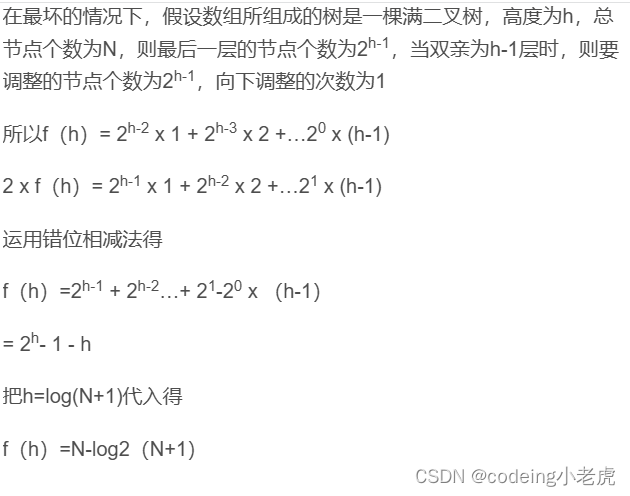
所以向下调整法建堆的时间复杂度为O(N),向下调整法的时间复杂度为logN
d. 堆的插入
void HPPush(HP* php, HPDataType x) { assert(php); if (php->size == php->capacity) { int newcapacity = php->capacity == 0 ? 4 : php->capacity * 2; HPDataType* tmp = (HPDataType*)realloc(php->a,sizeof(HPDataType) * newcapacity); if (tmp == NULL) { perror("realloc fail!"); return; } php->a = tmp; php->capacity = newcapacity; } php->a[php->size] = x; php->size++; AdjustUp(php->a, php->size - 1); }ⅰ. 时间复杂度
运用了一次向上调整法时间复杂度为O(logN)
e. 堆的删除
堆的删除要交换堆顶元素和最后一个元素,把size--,在用一次向下调整法就可以了,不可以直接删除堆顶元素再建堆,一来这样时间复杂度增大了,二是删除堆顶元素,元素之间关系错乱了,父子变叔侄,兄弟变父子
void HPPop(HP* php) { assert(php); assert(php->size > 0); Swap(&php->a[0], &php->a[php->size - 1]); php->size--; AdjustDown(php->a, php->size, 0); }ⅰ. 时间复杂度
运用了一次向下调整法,时间复杂度为O(logN)
f. 堆的判空
bool HPEmpty(HP* php) { assert(php); return php->size == 0; }ⅰ. 时间复杂度
时间复杂度为O(1)
g. 取堆元素
HPDataType HPTop(HP* php) { assert(php); return php->a[0]; }ⅰ. 时间复杂度
时间复杂度为O(1)
h. 堆的摧毁
void HPDestroy(HP* php) { assert(php); free(php->a); php->a = NULL; php->size = php->capacity = 0; }i. 堆的排序(堆的向上调整法和向下调整法不传结构体的原因)
void HPSort(HPDataType* a, int n) { //这里不用建大堆选出最大数,建堆的时间复杂度为O(N) // 取出最大数后再N-1个数进行建堆,执行次数为N-1 //n个数,执行次数为N+N-1+N-2.....+1;时间复杂度为O(N^2) //,和冒泡排序时间复杂度为一样,没有时间上的优势 for(int i=(n-1-1)/2;i>=0;i--) { AdjustDown(a, n, i); } //对数组进行升序排列 //需要建大堆 //收尾交换 //把最后一个值不放在堆中,建大堆选出最大数,将其放在最后 int end = n-1; while (end > 0) { Swap(&a[end], &a[0]); AdjustDown(a, end, 0); end--; } }原因:由于向上调整法和向下调整法传结构体每次都需要建一个堆,太耗费时间,但如果传数组,在用调整法时就不需要写一个堆的结构体,比如堆的排序
ⅰ. 时间复杂度
向下调整法建堆的时间复杂度为O(N),排序的时间复杂度为和向上调整时间一样,计算方式一样,为O(NlogN),总的时间复杂度为O(NlogN)。
习题:在很大的数据个数中找出最大的k个数,借用文件的形式实现
#define _CRT_SECURE_NO_WARNINGS 1 #include<stdio.h> #include<assert.h> #include<time.h> #include<stdlib.h> void Swap(int *a,int *b) { int tmp = *a; *a = *b; *b = tmp; } void createNData() { srand((unsigned int)time(NULL)); const char* file = "data.txt";//要打开的文件 FILE* fin = fopen(file, "w"); if (fin == NULL) { perror("fopen fail"); return; } for (int i = 1; i <= 20; i++) { int x = rand() % 10000 + 1; fprintf(fin, "%d\n", x); } fclose(fin); } void AdjustDown(int* a, int n, int parent) { int child = parent * 2 + 1; while (child < n) { if (child + 1 < n && a[child] > a[child + 1]) { child++; } if (a[parent] > a[child]) { Swap(&a[parent], &a[child]); parent = child; child = parent * 2 + 1; } else { break; } } } void topk() { int k; int x; const char* file = "data.txt";//要打开的文件 printf("要找出的最大数字的个数:>"); scanf("%d", &k); FILE* fout = fopen("data.txt", "r"); if (fout == NULL) { perror("fopen fail"); return; } int* minheap = (int*)malloc(sizeof(int) * k); if (minheap == NULL) { perror("malloc fail"); return; } for (int i = (k - 1 - 1)/2 ; i >= 0; i--) { AdjustDown(minheap, k, i); } while (fscanf(fout, "%d", &x) != EOF) { if (x > minheap[0]) { minheap[0] = x; AdjustDown(minheap, k, 0); } } for (int i = 0; i < k; i++) { printf("%d\n", minheap[i]); } fclose(fout); } int main() { createNData(); topk(); return 0; } 堆的实现全部代码
test.c
#define _CRT_SECURE_NO_WARNINGS 1 #include"Heap.h" int main() { HPDataType a[] = { 50,100,480,76,31,31,226 }; HPSort(a, sizeof(a) / sizeof(a[0]));//之前向上调整和向下调整就是为了这里 //直接传a数组,而不是 for (int i = 0; i < sizeof(a) / sizeof(a[0]); i++) { printf("%d ", a[i]);//排升序 } HP hp; //HPInitArray(&hp,a,sizeof(a)/sizeof(HPDataType)); //HPInit(&hp); //HPInitArray(&hp, a, sizeof(a) / sizeof(HPDataType)); //for (int i = 0; i < sizeof(a) / sizeof(a[0]); i++) //{ // HPPush(&hp, a[i]); //} //printf("%d", HPTop(&hp)); //HPPop(&hp); //for (int i = 0; i < sizeof(a) / sizeof(a[0]); i++) //{ // printf("%d ", (&hp)->a[i]); //} return 0; } Heap.c
#define _CRT_SECURE_NO_WARNINGS 1 #include"Heap.h" void HPInit(HP* php) { php->a = NULL; php->capacity = php->size = 0; } void Swap(HPDataType* a, HPDataType* b) { HPDataType tmp = *a; *a = *b; *b = tmp; } void AdjustUp(HPDataType* a, int child) //不传结构体,为了后面排序做准备,原因后面会解释 { assert(a); int parent = (child - 1) / 2; while (child>0) //parent>=0可以作为结束条件,但是一个巧合, //因为到最后是依靠当child==0,parent=(child-1)/2=-1/2=0时 //a[parent]==a[child]结束的 { if (a[child] < a[parent]) { Swap(&a[child], &a[parent]); child = parent; parent = (parent - 1) / 2; } else { break; } } } void HPPush(HP* php, HPDataType x) { assert(php); if (php->size == php->capacity) { int newcapacity = php->capacity == 0 ? 4 : php->capacity * 2; HPDataType* tmp = (HPDataType*)realloc(php->a,sizeof(HPDataType) * newcapacity); if (tmp == NULL) { perror("realloc fail!"); return; } php->a = tmp; php->capacity = newcapacity; } php->a[php->size] = x; php->size++; AdjustUp(php->a, php->size - 1); } HPDataType HPTop(HP* php) { assert(php); return php->a[0]; } void AdjustDown(HPDataType* a, int n, int parent) //不传结构体,为了后面排序做准备,原因后面会解释 { assert(a); int child = parent * 2 + 1; while (child < n) { //假设法 if (child + 1 < n && a[child] < a[child + 1]) { child++; } if (a[parent] < a[child]) { Swap(&a[parent], &a[child]); parent = child; child = parent * 2 + 1;//右孩子,不可以为左孩子,因为上面要比较 } else { break; } } } void HPInitArray(HP* php, HPDataType* a, int n) { assert(php); php->a = (HPDataType*)malloc(sizeof(HPDataType) * n); if (php->a == NULL) { perror("malloc fail!"); return; } memcpy(php->a, a, n * sizeof(HPDataType)); php->capacity = php->size = n; //向上调整 //for (int i = 1; i < n; i++) //{ // AdjustUp(php->a, i); // HPPush(php, php->size)//不可以,因为调用函数 // 时php->size在函数内还会增加 //} //向下调整 for (int i = (php->size - 1 - 1) / 2; i >= 0; i--) //数组的大小为size,对应下标为size-1,其数组最后一个元素 //的双亲为(size-1-1)/2; { AdjustDown(php->a, n, i); } } //时间复杂度为logN void HPPop(HP* php) { assert(php); assert(php->size > 0); Swap(&php->a[0], &php->a[php->size - 1]); php->size--; AdjustDown(php->a, php->size, 0); } bool HPEmpty(HP* php) { assert(php); return php->size == 0; } void HPDestroy(HP* php) { assert(php); free(php->a); php->a = NULL; php->size = php->capacity = 0; } void HPSort(HPDataType* a, int n) { //这里不用建大堆选出最大数,建堆的时间复杂度为O(N) // 取出最大数后再N-1个数进行建堆,执行次数为N-1 //n个数,执行次数为N+N-1+N-2.....+1;时间复杂度为O(N^2) //,和冒泡排序时间复杂度为一样,没有时间上的优势 for(int i=(n-1-1)/2;i>=0;i--) { AdjustDown(a, n, i); } //对数组进行升序排列 //需要建大堆 //收尾交换 //把最后一个值不放在堆中,建大堆选出最大数,将其放在最后 int end = n-1; while (end > 0) { Swap(&a[end], &a[0]); AdjustDown(a, end, 0); end--; } }Heap.h
#define _CRT_SECURE_NO_WARNINGS 1 #include<stdio.h> #include<stdlib.h> #include<assert.h> #include<stdbool.h> #include<string.h> #include<time.h> typedef int HPDataType; typedef struct Heap { HPDataType* a; int size; int capacity; }HP; void HPInit(HP* php); void HPInitArray(HP* php, HPDataType* a, int n); void HPDestroy(HP* php); // 插入后保持数据是堆 void HPPush(HP* php, HPDataType x); HPDataType HPTop(HP* php); // 删除堆顶的数据 void HPPop(HP* php); void HPSort(HPDataType* a, int n); bool HPEmpty(HP* php); void AdjustUp(HPDataType* a, int child); void AdjustDown(HPDataType* a, int n, int parent); void Swap(HPDataType* px, HPDataType* py); 